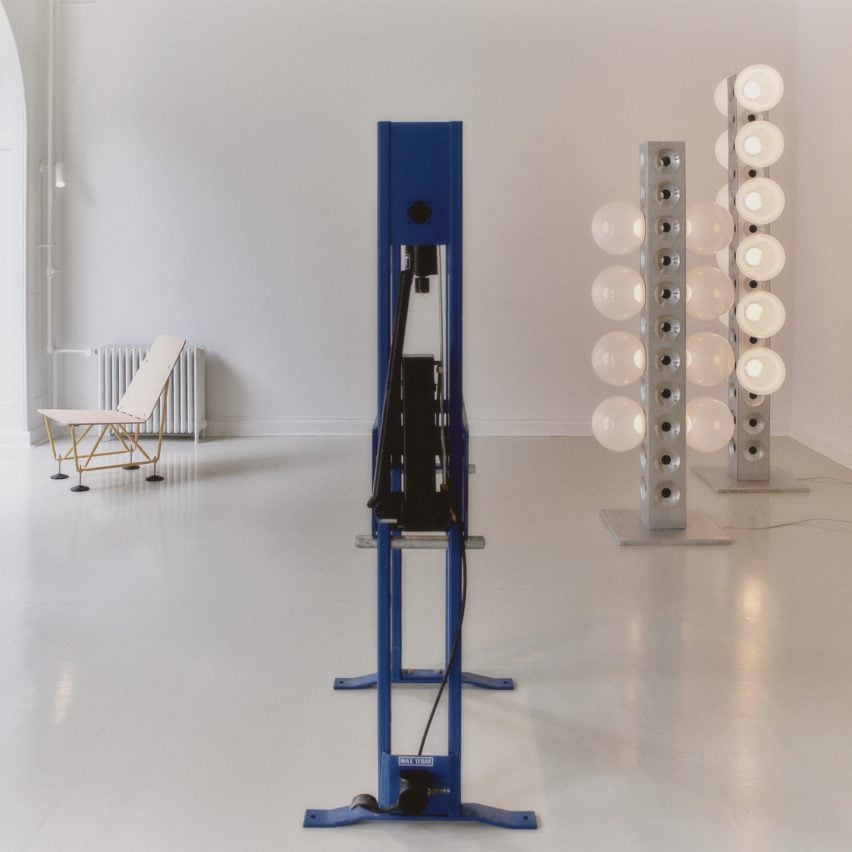Designers including Tom Dixon, Jonas Trampedach and John Tree have used a hydraulic press to create furniture, lamps and objects for an exhibition that is on show in Copenhagen as part of 3 Days of Design.
Trampedach established the annual Værktøj exhibition last year as a platform for exploring the role of tools in the design industry.

The inaugural edition displayed pieces made using a profile bending machine by Trampedach and members of the Værktøj collective Frederik Gustav, Kasper Salto and Michael Antrobus.
For this edition, the tool chosen is the hydraulic press – an industrial machine that is commonly used to apply pressure to an object for various purposes such as bending, flattening, forming or assembling.

“Throughout history, tools have been crucial to humanity’s ability to survive and innovate,” explained the designers in Værktøj’s manifesto. “From primitive stone tools to advanced machinery, tools have been key to shaping the world.”
“With the exhibition format, we want to communicate and demonstrate how our identity as designers is largely shaped by the tools we use; as they not only drive the development of ideas and creative processes but also leave a distinct imprint on the final product.”

For Værktøj 2, the original members plus four guest exhibitors were asked to create objects that can be produced fully, or in part, using a hydraulic press.
Trampedach designed a pair of chairs with near-identical forms – one in aluminium and one in oak. The press was used to form the curved shapes of the seats and backrests in moulded plywood and sheet metal.
Copenhagen-based British designer Antrobus used the tool to transform a sheet of washi paper into a self-supporting lamp featuring contoured curves that balance tension and compression.
Dixon‘s Totem light is made from a thin sheet of aluminium that is folded into a square profile. The metal is stiffened by adding perforated dimples regularly along its length that also support two rows of glass light fittings.

Salto produced a minimalist table made from pressed Oregon pine veneer. The wood is paired with a tempered glass top that is set into a groove and sits flush with the edges of the base.
The handles of Alvilde Holm’s Bow Ties chest of drawers, meanwhile, were made by pressing aluminium to create shapes that appear both rigid and soft.
The drawers sit within a wooden frame finished with red satin oil, resulting in a piece that the designer claimed resembles “a woman dressed in red with a bow tie.”

Line Depping and Jakob Jørgensen used the hydraulic press to form indentations in stainless-steel plates, which were then mirror-polished to reflect and distort light from a candle set into a sandstone block.
The Truss Chair by British designer Tree features a plywood seat and backrest supported by a structural space frame in aluminium. The metal was compressed to create fixing points, and the chair rests on 3D-printed feet.

Frederik Gustav’s Louver lamps combine aluminium frames with pressed aluzinc shutters that wrap around and conceal cylindrical light sources. Each shutter is fixed to a vertical pole that allows the amount and direction of the light to be adjusted.
According to the Værktøj team, the wide range of outcomes on display encourages the visitors to “reflect on how equipment shapes both process and outcome – and how tools quietly inform material choices, forms and ideas.”
The exhibition opened on 12 June at Gothersgade 30 in Copenhagen and will remain on show until 27 June 2025.
Last year, 3 Days of Design’s exhibitions included one featuring emerging designers from the Nordics. The ten key events this year have been featured in our roundup of the festival highlights.
The photography is by Peter Vinther.
3 Days of Design 2025 takes place from 18 to 20 June across eight districts in Copenhagen, Denmark. For more information about events, exhibitions and talks, visit Dezeen Events Guide.
The post Eight designers present products made using a hydraulic press at Værktøj 2 exhibition appeared first on Dezeen.

